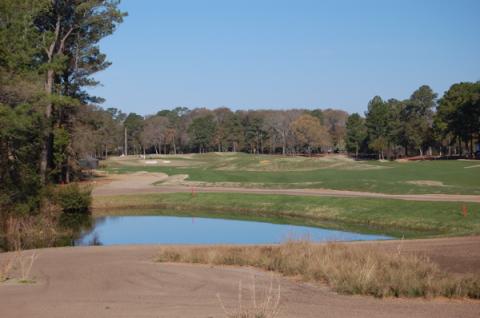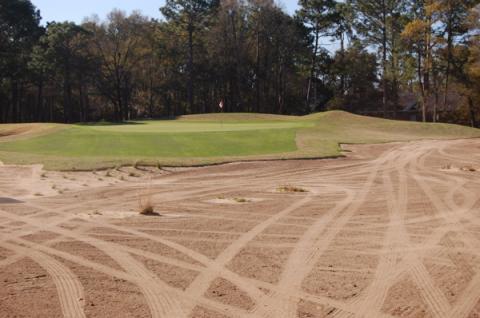
The par 5 12th hole at Founders features a hill that splits the fairway and contains a few nasty little bunkers. The green is in the distance at left with two spyglass bunkers in front.
Sea Gull Golf Club had become something of a joke. One of the first 20 courses to open in the golf happy Myrtle Beach area, Sea Gull anchored the bottom end of the Grand Strand in Pawleys Island...bottom in more ways than one. With a flat, boring and outdated layout on turf that had seen better days, and adjacent to a motel that had gone through several ownerships (and looked it), Sea Gull could not keep up with the sleek and modern layouts nearby. Even though Sea Gull charged the lowest green fees in the area, all but the first time visitors to the area knew you got what you paid for. They beat a path to the pricey but much better Caledonia, Pawleys Plantation and True Blue.
But now, after a $7 million investment and a dramatic makeover that kept Sea Gull's footprint but little else, the renamed Founders Club is keeping company with its classy neighbor courses as part of the Waccamaw
Thomas Walker, who came out of Gary Player's design shop, was given a nice budget and, apparently, a whole lot of sand, to remake the old Sea Gull. In the manner of the local True Blue Golf Club, Walker lined most of the fairways with waste bunkers, using them as cart paths rather than building the ugly and tougher-to-maintain asphalt or concrete paths. Waste areas are cleaner looking, but some locals whine about having to take too many shots from sand. Yet the fairways are still quite generous, as they were in Sea Gull's days, and the sand is compact enough to make most lies no big deal. One piece of advice; play earlier in the day if you can, before golf shoe marks and cart tracks increase the odds of a bad lie.
The other most noticeable feature at Founders, especially if you recall Sea Gull, are the moguls and pot
 bunkers. For the most part, the pot bunkers are window dressing, set well behind greens to create attractive horizons for approach shots. The ninth hole, a par 5 with a lake that runs the entire length of the fairway, features a green that tilts forward and is backed by an array of bunkers, some small and some medium size. Any play from back there is straight downhill onto a slick green. On the par 5 12th hole, however, a few of those little beasts are snuggled into the hill that forms the split fairway; the lower part of the fairway is the shortest path to the green, but the high road provides the best angle for the lay-up shot, before an approach over a large pond at the front of the green.
bunkers. For the most part, the pot bunkers are window dressing, set well behind greens to create attractive horizons for approach shots. The ninth hole, a par 5 with a lake that runs the entire length of the fairway, features a green that tilts forward and is backed by an array of bunkers, some small and some medium size. Any play from back there is straight downhill onto a slick green. On the par 5 12th hole, however, a few of those little beasts are snuggled into the hill that forms the split fairway; the lower part of the fairway is the shortest path to the green, but the high road provides the best angle for the lay-up shot, before an approach over a large pond at the front of the green.Conditions at Founders Club were wonderful on a beautiful breezy day. Except for once when my ball found a deep fairway divot hole, I did not come close to needing to roll the ball over. Fairways and tees seemed to be in late spring condition, a testament to the wise decision of the Founder's owners, the locally based Classic Golf Group, to push off opening the course from last September, during a drought, to the end of February. The greens, though, were the highlight for me, featuring an innovative heat-resistant Bermuda Emerald grass that has the properties of bent grass. I thought they putted wonderfully and were shaved to a fairly quick speed, especially for a public course. Founders Club is one of only two courses in the U.S. that uses that particular strain of grass (the other is in the Arizona desert).
The homes that surround the golf course rarely encroach on it, with most just beyond lakes and streams. Out of bounds stakes were well away from the fairways. The Hagley Estates neighborhood shows the kind of hodgepodge of housing styles you would expect from a community developed separately from its adjacent golf course. Some houses are small and old, not much more than 1,000 square feet, while others are more modern and would fit comfortably in a local planned community, like Pawleys Plantation.
The Hagley homeowners must love what has been done to the golf course. On one hole, I skulled a
 sand shot through the green and down the hill into the woods. My ball came to rest just beyond a for sale sign on an empty lot. A box next to the sign invited me to take a brochure. I did and was shocked to see a price of more than $200,000 for the half-acre lot. Just two years ago, at the end of Sea Gull's days, such a lot would have barely fetched $100,000. Resale homes are bumping up into the $400,000 territory, still reasonable for the golf-rich Pawleys Island area and the proximity to the interesting town of Georgetown, just six miles away. With reasonable home prices and an annual bargain membership of just $1,500 at the Founders Club, you might even have a few dollars left over for one annual round at Caledonia.
sand shot through the green and down the hill into the woods. My ball came to rest just beyond a for sale sign on an empty lot. A box next to the sign invited me to take a brochure. I did and was shocked to see a price of more than $200,000 for the half-acre lot. Just two years ago, at the end of Sea Gull's days, such a lot would have barely fetched $100,000. Resale homes are bumping up into the $400,000 territory, still reasonable for the golf-rich Pawleys Island area and the proximity to the interesting town of Georgetown, just six miles away. With reasonable home prices and an annual bargain membership of just $1,500 at the Founders Club, you might even have a few dollars left over for one annual round at Caledonia.The Founders Club, Highway 17, Pawleys Island, SC. Phone: 1 (800) 833-6337 / (843) 237-2299. Web: TheClassicGolfGroup.com. Architect: Thomas Walker. Par 72. Back tees: 7,007 yards. White tees: 6,394. Gold tees: 5,506. Rating and slope not available.

Waste bunkers are the cart paths at the Founders Club. Play early before carts and feet chew up the sand.



